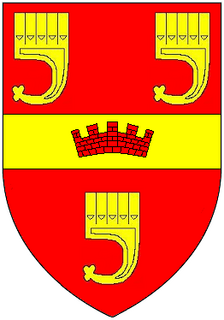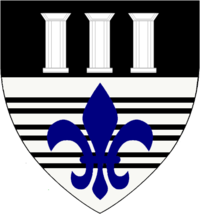
Earl Winterton, in the County of Galway, is a title in the Peerage of Ireland. It was created in 1766 for Edward Turnour, 1st Baron Winterton, who represented Bramber in the House of Commons. Turnour had already been created Baron Winterton, of Gort in the County of Galway, in 1761, and was made Viscount Turnour, of Gort in the County of Galway, at the same time as he was given the earldom. These titles are also in the Peerage of Ireland. Born Edward Turnour Garth, Lord Winterton was the son of Joseph Garth and his wife Sarah, daughter of Francis Gee and his wife Sarah, daughter of Sir Edward Turnour, Member of Parliament for Orford, elder son of Sir Edward Turnour, Speaker of the House of Commons from 1661 to 1671. His mother was sole heiress to the Turnor estates and on her death in 1744 he assumed by Royal licence the surname of Turnour.

Viscount Mersey, of Toxteth in the County Palatine of Lancaster, is a title in the Peerage of the United Kingdom. It was created in 1916 for the lawyer and politician John Bigham, 1st Baron Mersey. He had already been created Baron Mersey, of Toxteth in the County Palatine of Lancaster, in 1910, also in the Peerage of the United Kingdom. His son, the second Viscount, was a Deputy Speaker of the House of Lords and also served as Liberal Chief Whip in the House of Lords from 1944 to 1949. His son, the third Viscount, married Katherine Petty-Fitzmaurice, 12th Lady Nairne, the eldest daughter of Henry Petty-Fitzmaurice, 6th Marquess of Lansdowne and 10th Lord Nairne. They were both succeeded by their son, the fourth Viscount Mersey and thirteenth Lord Nairne. As of 2017 the titles are held by the latter's son, the fifth Viscount, who succeeded in 2006.
Viscount Devonport, of Wittington in the County of Buckingham, is a title in the Peerage of the United Kingdom. It was created on 22 June 1917 for the Liberal politician and former Member of Parliament for Devonport, Hudson Kearley, 1st Baron Devonport. He had already been created a Baronet, of Wittingham in the Parish of Medmenham in the County of Buckingham on 22 July 1908, and Baron Devonport, of Wittington in the County of Buckingham, on 15 July 1910. As of 2017 the titles are held by his grandson, the third Viscount, who succeeded his father in 1973.

Baron Rendlesham, of Rendlesham, is a title in the Peerage of Ireland. It was created in 1806 for the businessman Peter Thellusson, who also represented Midhurst, Malmesbury and Bossiney in Parliament. The Thellusson family were of French Protestant origin, but settled in Geneva, Switzerland, after the St. Bartholomew's Day massacre of 1572.

Baron Harris, of Seringapatam and Mysore in the East Indies and of Belmont in the County of Kent, is a title in the Peerage of the United Kingdom.

Baron Hardinge of Penshurst, in the County of Kent, is a title in the Peerage of the United Kingdom. It was created in 1910 for the diplomat the Hon. Sir Charles Hardinge, Viceroy and Governor-General of India from 1910 to 1916. He was the second son of Charles Hardinge, 2nd Viscount Hardinge. His son, the second Baron, served as private secretary to both King Edward VIII and King George VI.
Baron Hives, of Duffield in the County of Derby, is a title in the Peerage of the United Kingdom. It was created 7 July 1950 for the Ernest Hives, Chairman of Rolls-Royce Ltd. As of 2010 the title is held by his grandson, the third Baron, who succeeded his uncle in 1997.

Baron Grenfell, of Kilvey in the County of Glamorgan, is a title in the Peerage of the United Kingdom. It was created on 15 July 1902 for the military commander Sir Francis Grenfell. His eldest son, the second Baron, was Deputy Speaker of the House of Lords and Chairman of Committees from 1963 to 1976. As of 2010 the title is held by the latter's son, the third Baron, who succeeded in 1976. He previously worked for the World Bank. Lord Grenfell lost his seat in the House of Lords after the passing of the House of Lords Act 1999. However, in 2000 he was made a life peer as Baron Grenfell of Kilvey, of Kilvey in the County of Swansea, and was able to return to the House of Lords.

Baron Dickinson, of Painswick in the County of Gloucester, is a title in the Peerage of the United Kingdom. It was created on 18 January 1930 for the Liberal politician Willoughby Dickinson, who had previously represented St Pancras North in the House of Commons. He was the son of Sebastian Dickinson, Member of Parliament for Stroud from 1868 to 1874. As of 2019 the title is held by the first Baron's great grandson, the third Baron, who succeeded in 2019.
Baron Keyes, of Zeebrugge, and Dover in the County of Kent, is a title in the Peerage of the United Kingdom. It was created in 1943 for the prominent naval commander Admiral of the Fleet Sir Roger Keyes, 1st Baronet. He is chiefly remembered for his role in the Zeebrugge Raid in 1918, an attempt by the Royal Navy to neutralize the Belgian port of Zeebrugge which was used as a base for German submarine attacks on Allied shipping. Keyes had already been created a Baronet, of Zeebrugge, and of Dover in the County of Kent, in the Baronetage of the United Kingdom in 1919. As of 2010 the titles are held by his grandson, the third Baron, who succeeded his father in 2005. He does not use his title.
Baron Kirkwood, of Bearsden in the County of Dunbarton, is a title in the Peerage of the United Kingdom. It was created in 1951 for the Scottish engineer, trade unionist, Independent Labour Party and later Labour politician David Kirkwood. As of 2010 the title is held by his grandson, the third baron, who succeeded his father in 1970.

Baron Silsoe, of Silsoe in the County of Bedford, is a title in the Peerage of the United Kingdom. It was created on 18 January 1963 for the barrister Sir Malcolm Trustram Eve, 1st Baronet. He had already been created a Baronet, of Silsoe in the County of Bedford, on 18 January 1943. He was succeeded by his son, the second Baron. Known as David Silsoe, he was also a barrister. As of 2017 the titles are held by his son Simon, the third Baron, who succeeded in 2005.
Baron Mostyn, of Mostyn in the County of Flint, is a title in the Peerage of the United Kingdom. It was created in 1831 for Sir Edward Lloyd, 2nd Baronet, who had earlier represented Flint Boroughs and Beaumaris in the House of Commons. His son, the second Baron, sat as a Member of Parliament for Flintshire and Lichfield and served as Lord Lieutenant of Merionethshire.
Baron Mottistone, of Mottistone in the County of Southampton, is a title in the Peerage of the United Kingdom. It was created in 1933 for the soldier and Liberal politician J. E. B. Seely. He was the fourth son of Sir Charles Seely, 1st Baronet, and the uncle of Hugh Seely, 1st Baron Sherwood. The fourth baron, succeeded his half-brother in 1966. He notably served Lord Lieutenant of the Isle of Wight from 1986 to 1995 and as the last governor of the Isle of Wight between 1992 and 1995 and was succeeded by his son as the fifth baron, in 2011. In turn, the fifth baron was succeeded by his elder son in 2013.
Baron McNair, of Gleniffer in the County of Renfrew, is a title in the Peerage of the United Kingdom. It was created on 4 August 1955 for the lawyer and judge Sir Arnold McNair. He was the first President of the European Court of Human Rights. As of 2010 the title is held by his grandson, the third Baron, who succeeded his father in 1989.

Baron Tennyson, of Aldworth in the County of Sussex and of Freshwater in the Isle of Wight, is a title in the Peerage of the United Kingdom. It was created in 1884 for the poet Alfred Tennyson. His son, the second Baron, served as Governor-General of Australia, and his grandson, the third Baron, as a captain for the English cricket team. On the death in 2006 of the latter's younger son, the fifth Baron, the line of the eldest son of the first Baron failed. The title was inherited by the late Baron's second cousin once removed, the sixth and present holder of the peerage. He is the great-grandson of Hon. Lionel Tennyson, second son of the first Baron.
Baron Cochrane of Cults, of Crawford Priory in the County of Fife, is a title in the Peerage of the United Kingdom. It was created in 1919 for the Liberal Unionist politician and former Under-Secretary of State for the Home Department, the Hon. Thomas Cochrane. He was the second and youngest son of Thomas Barnes Cochrane, 11th Earl of Dundonald. As of 2017 the title is held by the first Baron's great-grandson, the fifth Baron, who succeeded his father in that year.
Baron Catto, of Cairncatto in the County of Aberdeen, is a title in the peerage of the United Kingdom. The only hereditary peerage newly conferred during the reign of King Edward VIII, the barony was created on 24 February 1936 for the businessman, banker and public servant, Sir Thomas Catto, 1st Baronet. He had already been created a baronet, of Peterhead, on 5 July 1921. As of 2018 the titles are held by his grandson, the third baron, who succeeded his father in 2001.
Baron Rootes, of Ramsbury in the County of Wiltshire, is a title in the Peerage of the United Kingdom. It was created on 16 February 1959 for the businessman Sir William Rootes. He was head of the motor car manufacturer Rootes Ltd. As of 2010 the title is held by his grandson, the third Baron, who succeeded his father in 1992.
Baron Renwick, of Coombe in the County of Surrey, is a title in the Peerage of the United Kingdom. It was created on 23 December 1964 for the businessman and public servant, Sir Robert Renwick, 2nd Baronet. He notably worked for the Air Ministry and the Ministry of Aircraft Production during the Second World War. The Renwick Baronetcy, of Coombe in the County of Surrey, was created in the Baronetage of the United Kingdom on 28 June 1927 for his father, Harry Renwick. As of 2020 the titles are held by the first Baron's grandson, the third Baron, who succeeded in that year. The second baron was active in the House of Lords until the House of Lords Act 1999, when he lost his seat in parliament.












